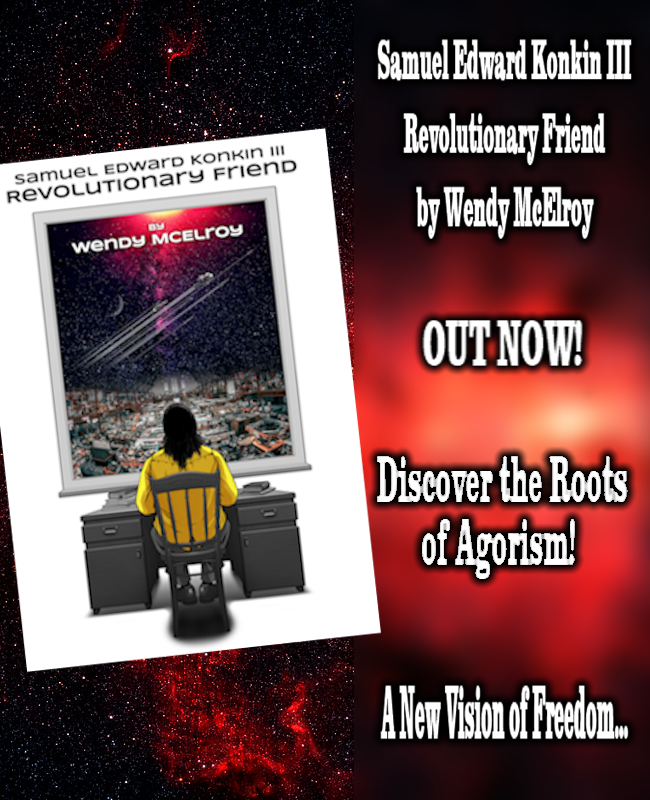
An Agorist Revolution through Fiction
Suppose you are writing a Science Fiction story set in the future. You want one or more model societies to use as background and possibly contrast. One you consider is libertarian. What should it look like; more importantly, that should it not resemble. Libertarian-like societies have been presented by Heinlein, LeGuin, Russell, Kornbluth, Anderson and others. None were written in light of the recent “explosion” of libertarian theory (since 1969); they were the author’s idea of a free society independent of the new scholarly literature and movement debates.—Samuel E. Konkin III (SEK3) “Future Societies: Libertarian Alternative.”
SEK3’s birthday was July 8th, just one day after that of the science-fiction (SF) legend Robert A. Heinlein. SEK3 habitually threw a Heinlein-Konkin Birthday Party that was open to fellow libertarians and “frefans’—a term SEK3 coined to describe libertarian SF fans, with “frefen” being the plural. At about 11 p.m. on the night of every July 7th, SEK3 would hoist his first glass of black beer, which signaled the beginning of festivities. The SF novelist, J. Neil Schulman, commented, “When both were alive, it was not uncommon for me to put in a phone call to Mr. Heinlein so I could put Sam on the phone with him, and they could wish each other Happy Birthday.” This is how highly SEK3 viewed not only Heinlein but SF itself.
Those who know SEK3 through his writings on anarchy and Agorism may be surprised to learn that he considered fiction to be more important than nonfiction as a revolutionary force for change in society. He focused on SF and fantasy and it was a natural choice. The first step in SEK3’s path to Agorism was Heinlein’s novel The Moon is a Harsh Mistress. When the novel was published in a paperback edition, SEK3 read it almost immediately. It is easy to imagine the 21-year-old SEK3 being captivated by the libertarian revolution launched by colonists on the moon against a totalitarian earth. And, then, there was the Rational Anarchist who intellectually led the revolution. Professor Bernardo de La Paz was based upon Robert LeFevre who advocated a school of anarchism called Autarchism; LeFevre promoted individualism, nonviolence, moral responsibility, and self-reliance as a lifestyle. When SEK3 discovered the Professor was modeled after a real and living person, he went out of his way to meet LeFevre.
SEK3’s life was as much about frefandom as much or more than it was about Agorism. His fannish passion attracted novelists, playwrights, and screenwriters because of shared interests and SEK3’s enthusiasm for their work. People drawn by his love of SF often stayed for his take on nonfiction. Schulman wrote of their first meeting NYC in 1974, “We found out almost immediately that we shared an interest in science fiction (particularly Heinlein) and the works of C.S. Lewis, whose Narnian chronicles I’d read as a child. Sam was only the second other person in my life I’d met who had read Heinlein, and the first other person I’d met who’d read Lewis. It was Sam who told me that Lewis had written more than the Narnian children’s books, introduced me to Lewis’s nonfiction and adult fiction, and took me to my first meeting of the C.S. Lewis Society of New York, which we attended together regularly.” Much of Lewis’s nonfiction is called Christian apologetics—that is, the defense of Christianity against objections. Schulman came to believe in God. SEK3 attended the meetings despite his atheism because he found the ideas and discussion to be stimulating; and, then, were the wonderful Narnian fantasies.
It is rare for a libertarian to be as well read in fiction as in nonfiction, let alone to tout fiction as the more revolutionary form of expression. Indeed, most libertarians would dismiss this possibility. Within so-called respectable circles, especially within academia and institutes, fiction authors receive little more than a passing nod or—if they are popular among students—they may be included in seminars to which they are not invited, unless they are politically correct. It is rare for such authors to be invited as speakers even to libertarian conferences as speakers. Perhaps they are viewed as less intellectual or important than voices from academia; perhaps the institutes fear alienating donors by appearing “superficial” or not serious about ideas. Years ago, a conference organizer told me she was determined to reach the “mainstream” by sponsoring writing seminars. “Who”, she inquired, “could do a good presentation on science fiction?” I rattled off a list of several authors, all of whom were successful working writers and eloquent people. “No, no,” she shook her head. “Who can do a presentation?” In the end, she invited a philosophy professor who taught a class on modes of “being” in SF.
The movement’s dismissal of its own fiction and fiction writers is baffling when you consider how many libertarians became politically aware through the novels of Ayn Rand. If the title of Jerome Tuccille’s pioneering book—It Usually Begins with Ayn Rand—has any accuracy, then SF should receive automatic respect; Rand’s first book, Anthem, is a dystopian novella set in an unspecified future, which chronicles the protagonist’s discover of individualism. Many other libertarians entered the movement through the SF of Heinlein, Robert Anton Wilson, L. Neil Smith, James Hogan, David Brin, Vernor Vinge, and Schulman. These writers are among the best propagators of ideas in our culture. Although they are sometimes lauded by the wider public, they are largely without honor in their own land.
It has not always been this way. Literature played a prominent role in Benjamin R. Tucker’s 19th-century individualist-anarchist periodical Liberty, for example, even though its clear emphasis was on political issues. Tucker risked imprisonment by publishing and selling an edition of Walt Whitman’s book of poetry, Leaves of Grass, which was deemed obscene by the post office. And he was as keenly aware of novels and poetry from abroad as he was of revolutionary political tracts. His fascination with cosmopolitan literature led him to publish The Transatlantic (1889-1890), a biweekly literary magazine. The many fiction works translated by Tucker or his associates include: Claude Tillier’s My Uncle Benjamin; Emile Zola’s Money and Modern Marriage; Octave Mirabeau’s A Chambermaid’s Diary; Felix Pyat’s The Rag Picker of Paris; and Sophie Kropotkin’s The Wife of Number 4,237. These and other works of literature were standard offerings in the Liberty bookstore.
In short, the freedom movement was once vibrant with fiction that it valued as highly as nonfiction. SEK3 was something of a throw back to the 19th-century attitude toward fiction, except that he elevated fiction to a higher status than nonfiction. The 20th-century anarchist, Murray N. Rothbard, knew this well and seemed to view it as an eccentricity on SEK3’s part—that is, until the two men had a serious falling out. Then Rothbard attacked SEK3 at a point that Rothbard believed showed SEK3’s libertarian weakness: SF. In the essay, “History of the Libertarian Movement,” in which SEK3 referred to himself in the 3rd person, he explained:
Relations between MNR and SEK3 were maximally strained during 1977 when Rothbard joined the Kochtopus and moved to San Francisco. Rothbard was described as the “Darth Vader” of the Movement (Star Wars had just been released). Rothbard lashed back with his attack on the “space cadets” of science-fiction oriented libertarians, and was attacked himself within the LP by “space cadets” who labeled his faction “grubeaters.” [Note: Rothbard also used the term “space cadets” simply to describe unrealistically utopian people, such as futurists.]
SEK3’s commitment to frefandom rode a rail that paralleled his advocacy of anarchism and Agorism. The two are natural partners. In an essay called “A Political History of SF,“ Eric S. Raymond argued this point. “Science fiction, as a literature, embraces the possibility of radical transformations of the human condition brought about through knowledge.” Its stories take place “within a knowable universe, one in which scientific inquiry is both the precondition and the principal instrument of creating new futures.” The essay correctly calls “John Wood Campbell and Robert Heinlein the editor and the author who invented modern science fiction.” It states, “A political aura went with the hard-SF style, one exemplified by Campbell and right-hand man Robert Heinlein. That tradition was of ornery and insistent individualism, veneration of the competent man, an instinctive distrust of coercive social engineering and a rock-ribbed empiricism that valued knowing how things work and treated all political ideologizing with suspicion.”
SEK3 would have agreed with every word, as his content of reading material after The Moon is a Harsh Mistress can attest. As a student at the University of Wisconsin at Madison, where SEK3 pursued a degree in Chemistry, his roommate Tony Warnock introduced him to the works of Rand, Rothbard, LeFevre, and other notable libertarian theorists such as Ludwig von Mises.
In 1971, he moved to NYC to pursue a PhD in theoretical chemistry at New York University (NYU). He lost interest in the degree but became more deeply involved in SF and libertarian theory. Acting on his ever-energetic drive to influence and organize, he became a prominent member of the NYU Science Fiction Society (NYUSFS), founding the associated APA-NYU (APA=Amateur Press Association). Fancyclopedia3 (F3) explains APA-NYU’s origin. “In the winter of 1973-74….SEK3 paid a visit to southern California, attended a LASFS (Los Angeles Science Fiction Society) meeting and participated in an APA-L collation.” Returning to NYC, he started APA-NYU.
Earlier in SKE3’s NY stay, he had started publishing his fanzine New Libertarian Notes (NLN, 1971 to 1975) and Clear Ether! (CE!)
A mixture of political and fannish material, NLN appeared in 1971. The first issues included reviews of Heinlein and Poul Anderson, a rare Heinlein interview conducted by Schulman, as well as the beginning of SEK3’s own Rann Gold trilogy; in finished form, it consists of Agent for Anarchy, Statesman, and Dragon’s Bane. Of the trilogy, SEK3 wrote in his booklet The Last Whole Introduction to Agorism, “’Agent for Anarchy’ (1971) the first Rann Gold story, preceded agorism but the sequels, ‘The Statesman’ (1973) and ‘Dragon’s Bane’ (1975), were progressively more influenced by it, and the background history was not set until the third. All were published in New Libertarian Notes and its successor, New Libertarian Weekly.”
CE! has been described as SEK3’s “all-purposes personalzine” that was “was not available by subscription, only in APAs” with Volume 1 being published in APA-NYU. Arguably, it was his main artistic outlet. In the pages of CE!, SEK3 explained that the personalzine derived its title from the Lensman series. One of his associated publications—…And on Green—was the Lensman’s way of saying “on target.”
Then came the move to Long Beach. SEK3 and three companions who traveled with him formed the core of an agorist community called Anarchovillage; they also plunged into the local SF-fantasy scene. In fact, the four anarchists plunged into it even before they arrived. Their beat-up car—dubbed the “Terror Toyota”—took 3 weeks to drive across country because of SF side-jaunts. SEK3 recalled, “We stopped in Louisville, Kentucky, for the first Rivercon…and visited the best-known libertarian science-fiction fan back then, Richard E. Geis, in Portland, Oregon.” Their first destination, however, was libertarian. They slept on the floor of Dana Rohrabacher who was probably the best-known libertarian activist back then.
SEK3 was an inveterate SFCon goer who was well known with in fandom for his fanzines and his intellectual room parties. SEK3 usually brought his own party with him, as well, in the form of friends and fellow writers. Schulman remembered, “Sam took me to my first science-fiction convention, 1971’s Lunacon, in New York City, to my first world science-fiction convention, Torcon, in Toronto, ON, in 1973, and to my first meeting of the Los Angeles Science Fantasy Society (LASFS). We joined the just-formed Southern California C.S. Lewis Society together in 1975, and Sam and I each served on its governing council for a number of terms.”
SEK3’s first SF Con appears to have been in 1969. He wrote, “Arriving at St. Louis, Labor Day, 1969, your author was as interested in the St. Louis World Science Fiction Convention as much as the national YAF convention” to which he was a delegate. Again, SF and politics ran on parallel rails. Woody Bernardi of the Vegas SF Association and a friend of SEK3 stated in memorium, “Sam went on to attend cons across the country and even made it to a WorldCon or two in Europe….Sam also pubbed his fannish Daily FreFanzine, designed to compete with the official daily organ of the given Con. Sam pubbed Daily FreFanzine each day of every con he attended since its inception at the El Paso Westercon.” F3 offers a different time frame for FreFanzine’s inception “A Libertarian SF APA” it was “founded by Samuel Edward Konkin III in 1975 at the NASFi [Los Angeles]. Anders Monsen corroborates the Westercon origins, however. “I remember putting out the first issues of the Daily FreFanzine at the El Paso Westercon in 1996 with Sam.” It is likely F3 is confusing Frefanzine with one of SEK3’s other publications.
But F3 gives a fair appraisal of SEK3’s involvement in FreFanzine. “He was a regular contributor, but never was its Overall Editor (OE).” F3 quotes SEK3, “By the way, I’ve avoided OEship not only to get out of the work, but also because I am strongly identified with a ‘purist’ strain of radical libertarianism which is anathema to many more conservative ones who might otherwise wish to participate….” The entry remarked, “There was a tradition of collating FreFanzine on almost every Con Konkin and his anarchofriends attended.”
When he was not attending Cons or collating periodicals, SEK3 created organizations that furthered frefandom. One was the Karl Hess Club, which was a seamless blend of SF and politics. The Club was established on April 30, 1994 by SEK3, J. Kent Hastings, Brad Linaweaver, and Mike Everling as a monthly gathering for dinner and a speech which met in Marie Callender’s at Marina del Rey. The topics addressed were far broader than frefandom but it was a prominent theme and constant presence. The Hollywood Investigator reported on one meeting: “Libertarian Screenwriters Discuss Sci-Fi, Election 2000, and 9/11.” USS The notable SF and fantasy authors in attendance included:
“J. Neil Schulman, scripter for the New Twilight Zone (Profile in Silver) and author of The Frame of the Century (suggesting OJ’s innocence),
Brad Linaweaver (Sliders: The Classic Episodes, Moon of Ice),
Victor Koman (The Jehovah Contract — under option to Hollywood),
John DeChancie (Other States of Being, Witchblade: Talons),
“Anarchist” playwright Ben Pleasants, and
Thomas M. Sipos (Vampire Nation)”
The preceding provides only a glimpse into SEK3’s commitment to frefandom as a tool of revolution as powerful as scholarship or traditional activism—indeed, SEK3 believed it was more powerful. A full account requires a book-length treatment. Every treatment, however, without mention of SEK3’s most important periodical: the New Libertarian Weekly (NLW, 1975 to 1977), which evolved into New Libertarian (NL, 1978 to 1990). Again, SF melded with Agorism.
101 issues of NLW appeared; 187 of NL. The most important issue for this article, however, is the last one of NL—#187. Koman, who established KoPubCo Publishing Division of the Triplanetary Corporation to preserve and spread SEK3’s work, described the final issue.
This is the BIG one! New Libertarian’s last and greatest All Science Fiction issue, with stories by L. Neil Smith and Øyvind Myhre, a review of Destination: Moon by Brad Linaweaver, tributes to Robert A. Heinlein, and The Prometheus Meltdown by Robert Anton Wilson, Robert Shea, Victor Koman, and Brad Linaweaver, with L. Neil Smith and J. Neil Schulman. Also, a previously unpublished letter from Robert A. Heinlein himself on “Why I’m Not Bob!” These original issues are from a very small number that escaped The Great Storage Locker Default, in which dozens of cases of New Libertarian magazines, constituting over 50% of extant copies, were either auctioned off or dumped by a storage locker facility, losing them to posterity.
As usual, the cover was striking: a space-opera-style graphic of Heinlein holding a blaster, with planets suspended in the black sky behind him. From 1974 to his death in 2004, SEK3 supported himself as a pre- and post-production specialist for periodicals and books. His talents grew from typesetting and layout to book design and graphic art, although it is not clear the NL #187’s cover is SEK3’s work. Whether it is his handwork, this and other covers have an eye-grabbing quality.
SEK3’s editing or publishing career did not end with #187, but it is the high point. Output of his own material thereafter was sporadic. It is appropriate that the high point concludes a theme running through his life. From the conversion experience of The Moon is a Harsh Mistress to the annual Heinlein-Konkin Birthday to the final issue of NL in which his mentor is honored, the running theme in SEK3’s life was Heinlein.
(Note: An essential aspect of SEK3’s impact on libertarian fiction was his personal influence on many writers that equaled the influence of Heinlein on him. This is unaddressed here because another article—“Anarchovillage: Ground Zero of Agorism”—deals with this facet of SEK3’s personality. Scroll to near the end.)
Current libertarianism woefully misinterprets how ideas propagate through society and politically inspire people. Fiction can reach the heart and the imagination in a way that nonfiction rarely does. People embrace causes with their hearts and souls as often or more often than with their rational faculties. SEK3 realized this. He did not agree with all of Ursula K. Le Guin‘s positions—even though he respected and defended her in print against political critics—but he fully shared her view of revolution. “You cannot buy the Revolution. You cannot make the Revolution,” she wrote in The Dispossessed. “You can only be the Revolution. It is in your spirit, or it is nowhere.” For SEK3, the spirit of revolution within him was SF and fantasy.







